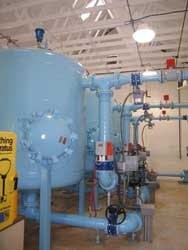Since the U.S. Environmental Protection Agency reduced the federal arsenic standard to a maximum contamination level of 10 ppb in drinking water in January 2006, attention has focused on areas of the country with the highest arsenic levels. Western states such as Arizona, New Mexico and Nevada, and Midwestern states such as Michigan and Indiana, have become hotbeds of arsenic treatment activity.
Perkasie, Pa., is located about 40 miles north of Philadelphia. The Perkasie Borough Authority operates a water and wastewater system that meets the needs of about 4,500 housing units and 200 commercial or industrial customers in three different municipalities. With a total system demand of .750 million gal per day (mgd) and the ability to expand to 1.34 mgd, the authority's water is supplied by six wells that operate at distribution capacities of 120 gal per minute (gpm) to 500 gpm. Chlorine is used as the system's disinfectant; polyphosphate for corrosion control; and in well #10, a stripping tower is used to remove trichloroethylene caused by industrial contamination in the 1950s and 1960s. Three of the wells have elevated levels of arsenic, including well #11, with an arsenic level measured at 12 ppb.
With a looming January 2006 EPA deadline and the knowledge that the Pennsylvania Department of Environmental Protection did not provide extensions to facilities that did not meet the new EPA standard, the borough shut down the #11 well in November 2005 and demolished the building in preparation for the installation of a new arsenic system in 2006. With adequate capacity in the three wells not contaminated by arsenic, the authority also closed the other two contaminated wells prior to the EPA deadline.
Gary J. Winton, general manager of Perkasie Borough Authority, and his staff had investigated a variety of arsenic removal methods and were aware of the successful use of the adsorption process, using iron-based media, in many parts of the country. In fact, nearby Hilltown Township had installed a 300-gpm SORB 33 arsenic removal system from Severn Trent Services early in 2006. After a bidding process for an iron-based media adsorption system, the authority also selected the SORB 33 system utilizing the Bayoxide E33 arsenic removal media.
To extend the life of the media, only two of the adsorbers are used each day—i.e., on day one, water flows from adsorber #1 to #2; on day two, water flows from adsorber #2 to #3; and on day three, water flows from adsorber #3 to #1; and so on. "We expect that alternating the use of the three adsorbers will improve the useful life of the Bayoxide media," Winton said. "We believe we will get 45 months of use out of the media before we will need to change it out – maybe longer."
The system treats a portion of the well's flow—160 gpm—and then blends it with the remaining 340 gpm, providing water with an arsenic level of eight to nine ppb. This blending procedure, which also extends the life of the Bayoxide media, has been recognized by the PADEP, which awarded a $250,000 "Growing Greener" grant to assist with the arsenic removal system's purchase. The purpose of the Growing Greener program is to restore watersheds and streams, reclaim mined lands and remediate abandoned mine drainage.
"Based on everything we'd seen before selecting our system, we were believers in the effectiveness of iron-based adsorptive media," said Winton. "It's the premier arsenic removal technology, and our SORB system has done everything we expected. We've been very satisfied with it, and we're also considering the feasibility of using the system for well #12, where arsenic levels have measured 37 ppb."

